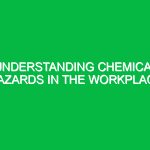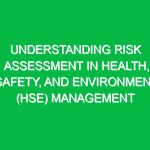Introduction to Risk Analysis in HSE
Risk analysis serves as a cornerstone in the realm of Health, Safety, and Environment (HSE) management systems. It entails systematically identifying, evaluating, and mitigating risks that can adversely affect the health and safety of employees and the surrounding environment. This process is not merely a regulatory requirement; it is a proactive approach that fosters a culture of safety and responsibility within organizations. The relevance of risk analysis extends beyond compliance; it cultivates an environment where potential hazards are anticipated and managed before they can cause harm.
Imagine a construction site where a simple oversight regarding safety protocols leads to a serious accident. The aftermath not only impacts the workers involved but also affects their families, the community, and the organization’s reputation. This scenario highlights the critical nature of effective risk analysis in preventing accidents and ensuring a safe workplace. Employers must understand that integrating risk analysis into their HSE management systems is not just a good practice; it is essential for sustainable operations.
Identifying Hazards and Risks
Risk analysis begins with the identification of potential hazards. In the HSE context, hazards can be categorized into several types:
Physical Hazards
These include environmental factors that can cause harm. For instance, working at heights poses a risk of falling, while machinery operation can lead to physical injuries if safety measures aren’t adhered to.
Chemical Hazards
Exposure to harmful substances like toxic chemicals, flammable materials, or even biological agents can lead to serious health issues. Industries dealing with chemicals must adopt stringent safety measures to mitigate these risks.
Ergonomic Hazards
These arise from workstation design or work practices that can lead to musculoskeletal disorders. Poor lifting techniques or repetitive motions can cause long-term injuries.
Psychosocial Hazards
These include stress, harassment, or workplace violence that can affect mental well-being. An organization that neglects the psychological aspects of safety may face high turnover rates and decreased productivity.
The Process of Risk Analysis
Once hazards are identified, the next step is to assess the associated risks. This involves evaluating the likelihood of each hazard causing harm and the potential severity of that harm. A common approach is to use a risk matrix, which helps in visualizing and categorizing risks based on their likelihood and impact.
For example, consider a manufacturing plant where machinery poses a risk of injury. The likelihood of an accident occurring might be categorized as “likely,” while the potential severity of injuries could be rated as “serious.” This simple exercise helps prioritize which risks require immediate attention and resources.
Safety Precautions and Best Practices
Implementing effective safety precautions is pivotal in managing identified risks. Here are some best practices related to risk analysis in HSE management systems:
Regular Training and Awareness Programs
Training employees on safety protocols and risk management is essential. Regular workshops can keep safety procedures fresh in employees’ minds, ensuring they understand how to recognize and respond to hazards.
Use of Personal Protective Equipment (PPE)
Employers must ensure that appropriate PPE is available and mandatory in high-risk areas. This equipment includes helmets, gloves, goggles, and respiratory protection, tailored to the specific hazards of each job.
Incident Reporting and Investigation
A robust incident reporting system should be in place to capture near misses and accidents. Analyzing these incidents can provide valuable insights into risk patterns and help in refining safety measures.
Emergency Preparedness Plans
Organizations must develop and periodically test emergency response plans. This includes evacuation procedures, first-aid training, and communication protocols to ensure a swift and effective response to emergencies.
Continuous Monitoring and Review
Risk analysis is not a one-time activity; it requires ongoing evaluation and adjustment. Regular audits and reviews of existing risk assessments can identify new hazards and ensure that existing controls remain effective.
Regulations and Standards Governing Risk Analysis
Various regulations and standards guide the implementation of risk analysis in HSE management systems. Here are some key examples:
Occupational Safety and Health Administration (OSHA)
In the United States, OSHA sets and enforces standards to ensure safe and healthful working conditions. Their regulations require employers to perform hazard assessments and implement appropriate safety measures.
ISO 45001
This international standard outlines requirements for an occupational health and safety management system. It emphasizes the importance of risk assessment and encourages organizations to proactively manage risks.
Environmental Protection Agency (EPA)
The EPA regulates hazardous waste and environmental risks, ensuring that organizations consider the environmental impact of their operations in their risk analysis processes.
Case Studies in Effective Risk Analysis
Real-world examples can illuminate the importance of integrating risk analysis into HSE systems.
Case Study 1: The BP Deepwater Horizon Disaster
The catastrophic oil spill in 2010 serves as a stark reminder of the consequences of inadequate risk analysis. Investigations revealed that key risks had been undervalued or ignored, leading to devastating environmental impacts and loss of life. This disaster prompted a renewed focus on risk management in the oil and gas industry.
Case Study 2: The Role of Risk Analysis in Healthcare
In healthcare, risk analysis plays a vital role in patient safety. Hospitals that have implemented rigorous risk assessment protocols have seen a significant reduction in medication errors and infections. For instance, a hospital in Pennsylvania adopted a comprehensive risk analysis framework, leading to a 30% decrease in adverse events over two years.
Conclusion
Integrating risk analysis into Health, Safety, and Environment management systems is not just a regulatory necessity; it is a pathway to fostering a culture of safety and accountability. By identifying potential hazards, assessing risks, and implementing robust safety measures, organizations can protect their employees and the environment while enhancing their operational efficiency.
In an ever-evolving landscape of workplace safety, the importance of proactive risk analysis cannot be overstated. Organizations that prioritize risk management are not only complying with regulations but are also investing in their most valuable asset—their people. As risks evolve, so too must our strategies for managing them. By embracing a mindset of continuous improvement, we can create safer workplaces and a healthier environment for all.


